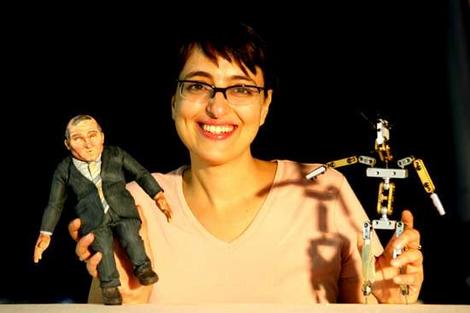Ursula Meier appeared on The Bat Segundo Show #277. This particular discussion was conducted in French and English. Many thanks to Aurélie Godet, who kindly assisted us in our conversation.
Ursula Meier is most recently the director of Home. The film is presently playing at the New Directors/New Films series, which is running between March 25 and April 5 at MOMA and the Film Society of Lincoln Center.
Condition of Mr. Segundo: Searching for a new home in Bulgaria.
Guest: Ursula Meier
Subjects Discussed: [List forthcoming]

EXCERPT FROM SHOW:
Correspondent: I must ask how you found this particular house and whether you had to consult some French transportation authority to get this particular freeway. What did you do for location scouting for something that was so essential to the movie? And I’m just curious if you had to broker any particular arrangements with any particular governmental agencies to get the cars. Maybe you could describe this.
Meier: (through translator) It was actually a lot of research. It was complicated to find that road. More than the house, it was the road that gave us a lot of work. We needed a large road. Like an abandoned highway. And it’s very difficult to find. Because if we approached highways that were under construction, they would quickly go into being bumped into the traffic. So it did not work. And then we looked around Europe. Firstly, the co-producing countries, France, Switzerland, and Belgium. And then other European countries. We went as far as Quebec. And it still didn’t work. Actually, if you had constructions on the road anyway, you had construction trucks going by all the time. So eventually, we tried another option, which was airport tracks. Landing tracks. And the problem there was that the landscapes around them were absolutely ugly and uninteresting. I was looking for something that would look well and, at the same time, have this abstract but real-looking quality to it. Also, we needed a road that would be long enough. You know, we couldn’t have anything that was short. Which was the case most of the time for airport tracks. Because we had all these cars. Approximately 300. With extras in them, driving them to create the traffic. And you needed them to drive fast enough. Like 90 miles per hour. So you needed a road that was long enough, far ahead so that they could break, and then re-stop.
BSS #277: Ursula Meier (Download MP3)
Listen: Play in new window | Download




 Correspondent: I also wanted to offer an observation. One moment in which Yuka, who is up for Connie, reveals that she was born in Japan. And the production team expresses some concerns because she can’t, in their view, possibly nail the right dialect because she wasn’t born in the States. In fact, Baayork Lee says, “There’s something about being born in America and fighting for a seat on the F train.” Seeing as how Yuka did, in fact, get the part, this is interesting to me. Because if you were to take such a judgment and put it into another occupation, it would be discrimination. So I am curious. If an actor has the chops, should they not be able to essentially get the part irrespective of the background? This is one of the interesting things, I think, about the film, in which you see such a blunt judgment — despite the fact that it’s done in all love — laid down on the table like that. So what of this dilemma?
Correspondent: I also wanted to offer an observation. One moment in which Yuka, who is up for Connie, reveals that she was born in Japan. And the production team expresses some concerns because she can’t, in their view, possibly nail the right dialect because she wasn’t born in the States. In fact, Baayork Lee says, “There’s something about being born in America and fighting for a seat on the F train.” Seeing as how Yuka did, in fact, get the part, this is interesting to me. Because if you were to take such a judgment and put it into another occupation, it would be discrimination. So I am curious. If an actor has the chops, should they not be able to essentially get the part irrespective of the background? This is one of the interesting things, I think, about the film, in which you see such a blunt judgment — despite the fact that it’s done in all love — laid down on the table like that. So what of this dilemma?
